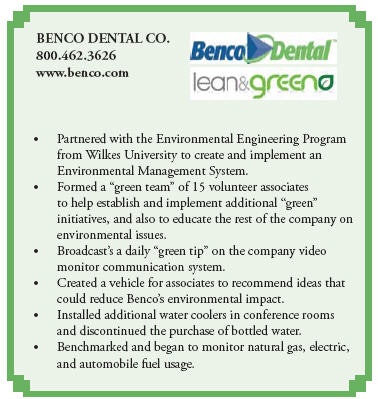
|
The importance of maintaining an environmentally friendly world for our future has come to the forefront of public attention. As dental professionals, it is important to be conscious of the environmental impact dental offices have on this earth. Although dental practices generate a considerable amount of waste, there are many simple solutions that can be implemented to help reduce our carbon footprint. This issue of THE DENTAL ADVISOR (September 2008, Vol. 25:7) discusses ways to incorporate "green" principles into your practice by reducing the quantity and toxicity of healthcare waste while maximizing efficiency and environmental awareness. A comparative table of steam sterilizers is included as well as information products for the dental office and recycling centers for dental practice waste.
Product Comparison Chart (Click link below to view)Steam Sterilizers Digital Radiography
The development of digital radiography has impacted dentistry in many ways. Digital images provide instant viewing capability; facilitate patient treatment procedures; increase diagnostic proficiency; and streamline storage, transfer, and retrieval of data. One of the greatest benefits of digital systems is the reduction in radiation exposure to the patient by 75% to 90%. By integrating digital radiography into your practice, the need for film as well as the photochemical wastes needed to develop the film can be eliminated. If your office is using traditional x-rays, here are some tips to help reduce waste:
Lead-Free Aprons
Going Paperless
With advances in computer technology and the development of user-friendly software, many dentists are making the decision to integrate a paperless environment into their practice. Digitizing patient charts, billing, and radiography not only increases efficiency of the practice and quality of patient care, but also eliminates over 90% of the paper use associated with daily normal practices. Going paperless saves paper, money, time, and trees! Maximizing Energy Efficiency
Conserving energy directly reduces the amount of power needed to run a dental office. By conserving energy, there is a reduction in harmful emissions to the environment and an additional cost savings to the practice. Reducing energy consumption can be easy and economically advantageous. Here are some ways you can take action:
Oilless Compressors
Dry Vacuum Systems
 Recycle and Reuse
Dental offices can effectively implement external and internal recycling practices to decrease the environmental impact of the office as well as reuse certain materials. Here are some tips:
The decision to make your office more "green" may initially take a little more effort, but it is simple and can often times be profitable to your practice. The commitment to reduce environmental impact should be discussed with your team. Discuss your "green" goals and develop an action plan for your practice. Assign team members tasks and ask them to report during team meetings. Everyone in the practice can contribute to the improvement of the practice and the environment.  Other "Green" Tips
Amalgam Use in the Dental Office
The mercury content in amalgam has been an ongoing concern for the environment. Currently, there are minimal regulations in place for dental practices in terms of amalgam disposal. Amalgam separators can be placed on delivery systems and help reduce the amalgam content in dental office waste water discharge. Amalgam separators are designed to remove waste amalgam from the water collected by the vacuum system before being discharged to municipal sewer systems. In July 2008, the ADA testified before the House Committee on Oversight and Government Reform regarding the requirement and regulation of amalgam separators. The ADA recommends not requiring an amalgam separator in every dental practice. Instead, the ADA is proposing a voluntary amalgam separator program; reasoning that the majority (99%) of mercury in dental practice wastewater is captured by water treatment plants (after traveling through the sewer system) and very little is deposited in ground water. The cost of installation and yearly maintenance was also stated by the ADA as a reason not to mandate amalgam separators, that dentists would be more compliant if the program was voluntary. The ADA has best management practices (BMP) for handling disposal of amalgam available on their Web site, www.ada.org. These include recommendations and guidelines on recycling, containment, and amalgam separators. ISO standards describe test methods for amalgam separators used with dental equipment in the dental treatment center, requiring the separator remove at least 95% of amalgam from the dental waste water. Amalgam should not be disposed of in the garbage or with hazardous waste. Also, amalgam should not be rinsed down the drain. Many communities incinerate medical waste. If amalgam waste ends up in one of these incinerated waste streams, the mercury can be released to the environment due to the high temperatures used in the incineration process.  Clinical Tips for Using Amalgam Safely
Tips for Safe Amalgam Removal
Dental Waste Recycling Companies
Requests for reprints should be directed to The Dental Advisor. |




















